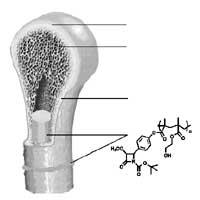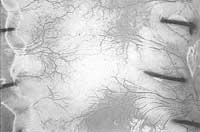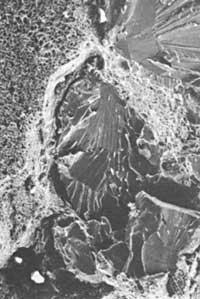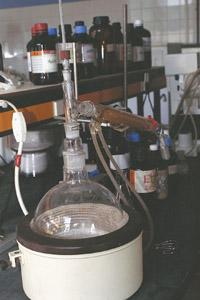New acrylic biopolymers to improve bone prostheses
1998/04/01 Aizpurua, Jesus Maria Iturria: Elhuyar aldizkaria
In bone fracture surgery, the use of prostheses is often essential. Although almost all of them were metallic, today the lightest and most adaptable polymeric prostheses are becoming more and more a success in medicine. However, prostheses made from biopolymers continue to present some errors, among which perhaps the most serious is the emptying of the prosthesis/bone interface after the implant operation (see figure). Although this phenomenon is due to complex factors, it seems to be largely due to the enzyme called leukocyte human elastase (OLL) released by the body itself, which irons or disrupts proteins in connective tissue and bone tissue through chemical reactions.
In fact, the HLE enzyme we all have, but thanks to the elastin inhibitor created by our body we can avoid its dangerous effect and use it only in beneficial biological functions.

The Department of Organic Chemistry of the Faculty of Chemistry of San Sebastian has been studying this problem for three years and synthesizing new molecules that can be inhibitors of EAE. Project C.N.R.S. Bordeaux (URA-35) is carrying out the participation of the French laboratory and the INASMET technology center in San Sebastian, in the grant to the Aquitaine-Basque Cooperation; the project is led by Claudio Palomo, Jesus Mari Aizpurua, Jean-Paul Picard and Iñaki Alava.
Already, thanks to new molecules of the N-Boc-b-lactam family prepared for the first time in the laboratory of the UPV/EHU, very small doses of inhibition of the EAE (four times lower than those of the shirt) have been obtained and according to the sessions carried out in cell cultures, these new b-lactam, in addition, hardly present toxicity. However, these compounds present another interesting feature, since they are polymerizable thanks to their acrylic functions in the structure, that is, they can be transformed into polymeric materials (or plastics). In this way, copolymers with 5% of these b-lactam have been prepared using methyl methacrylate monomers and hydroxyethyl methacrylate, obtaining transparent, versatile and consistent plastics. The most appreciated particularity of these new plastics is not, logically, their mechanical behavior, but their bioactivity, since they act as drugs before body EAE, causing inhibition only where it is needed (on the surface of the prosthesis) and not in the whole body.
However, there is still a long way to go to know if these new materials will be useful or not in the Medicine of the future: on the one hand, there are numerous biocompatibility sessions with animals and, on the other, it is necessary to conduct toxicological and clinical studies of their long-term effects. These sessions, both in favor and against, have never been held to date, since there are no other research groups that have developed biomaterials with anti-elastassic properties, such as the UPV.
- Project title: New biomaterials with anti-elastic properties based on b-lactam.
- Object of the project:- Synthesis of new anti-elastic b-lactam monomers.- Preparation and biological evaluation of new bioactive copolymers.
- Director: Claudio Palomo (Faculty of Chemistry of San Sebastian)
- Working team: J.M. Aizpurua, M.D. Gurrutxaga, I.Goñi (Facultad de Química de San Sebastián), Jean-Paul Picard (C.N.R.S. Bordeaux) and Iñaki Alava (INASMET)
- Department: Organic chemistry
- Faculty: Faculty of Chemistry of Donostia

Gai honi buruzko eduki gehiago
Elhuyarrek garatutako teknologia





